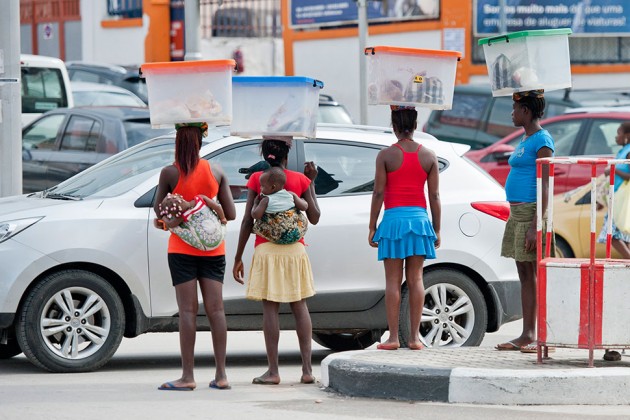In Luanda, the Rich Feast, the Poor Scramble – Businessweek

“My wheelbarrow is my life,” says Jacinto Baltazar. He makes a living by pushing his wooden cart, crafted out of planks and a Toyota Corolla tire, down a dirt road by a market on the outskirts of Luanda, Angola, and asking women if he can carry their groceries home. The 40-year-old father of eight charges 300 kwanzas ($3) per trip. On a good day he finds as many as 15 customers in the Viana municipality. During the rainy season he ferries people across pools of stagnant water. “I know I can’t make a lot of money as a wheelbarrow man,” he says, “but it keeps me busy, and I also feed my family.”
Baltazar is one of millions of Angolans left behind by the tenfold expansion of the economy since the end of a 27-year civil war in 2002. Two-thirds of the Angolan capital’s 6 million residents live on $2 a day even as the country boasts Africa’s second-biggest oil industry after Nigeria. It’s attracted billions of dollars in Chinese, U.S., and European investment. The influx of foreign workers has pushed rents for one-bedroom apartments in the city center to as high as $10,000 a month.
Luanda is ranked the world’s most expensive city for expatriates in Mercer’s 2014 Cost of Living Index, the second straight year it’s beaten better-known metropolises such as Singapore, Hong Kong, Shanghai, and Geneva. (Mercer is a consultant on executive compensation and recruitment.) Angola has another distinction: It ranks a dismal 161 out of 174 countries on Transparency International’s 2014 Corruption Perceptions Index.
The number of millionaires in the southern African country will more than double to 15,600 by 2030, according to a study last year by Johannesburg-based New World Wealth, a researcher on the rich of Africa and the Mideast. Angola President José Eduardo dos Santos’s daughter Isabel is Africa’s richest woman.
“Most Angolans are very poor because there’s a lack of wealth distribution, welfare support, and investment in education,” says Nelson Pestana, a political science professor at the Catholic University of Angola. Falling oil prices prompted the country to scale back investment plans for education, spreading 1 trillion kwanzas in funding over the next decade rather than an originally planned three years.
While the wealthy can feast on fresh seafood shipped in from Portugal, the country’s former colonial overlord, most Angolans subsist on funje, a paste made from corn or cassava, a tuber that costs $1 a kilogram. Plates of funje, combined with meat, fish, rice, and beans, sell on the street for 700 kwanzas.
Even people who work in the formal economy and make the monthly minimum wage of about $200 find that it barely covers the basics. The annual inflation rate in Luanda was 7.5 percent in November. For the 25 percent of Angolans whom the African Development Bank says are jobless, reliance on esquemas—Portuguese for “schemes”—is vital.
One of the more common is to sell electricity from the state power supplier to neighbors. Someone with enough cash to pay for the legal installation of electric cables can snake illegal lines to neighbors who aren’t as flush and charge them $10 a month. During the October-to-April rainy season, people are sometimes electrocuted when their homes are flooded.
Back in Viana, Baltazar doesn’t seem bitter about his plight as he pushes his wheelbarrow in search of customers. “My kids are going to school,” he says. “I’m optimistic tomorrow will be a better day.” Near the central bank headquarters, a 17-year-old girl is walking around in leopard-print shorts and high heels at 9 p.m., working the streets to supplement what she makes as a hairdresser. The rate of HIV infection among Angolan sex workers is 23 percent, according to the Joint United Nations Programme on HIV/AIDS. “Sometimes I’m paid and well treated; other times I’m forced to do it for free,” she says. “This is the price I have to pay for being poor and powerless.”


